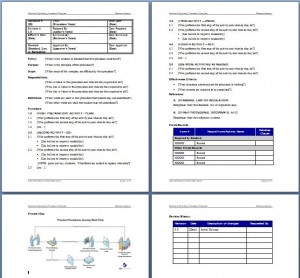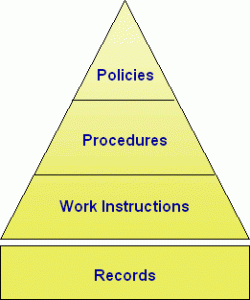Creating a Standard Operating Procedure Checklist for Your Business

In today’s fast-paced business world, finding ways to streamline operations and ensure consistency and quality is essential. One way to accomplish this is by documenting standard operating procedures (SOPs). An SOP is a step-by-step guide that outlines how to perform a specific task or process. By creating an Standard Operating Procedure checklist, you can provide your team with a clear set of instructions that will help them work more efficiently and effectively. In this article, we will guide you through the process of creating an effective SOP checklist for your business.
Understanding the Importance of Standard Operating Procedures (SOPs)

MS Word Procedure Template
Standard operating procedures are an essential component of any successful business. They provide a clear and concise set of guidelines for employees to follow, ensuring that tasks are completed efficiently and effectively. SOPs are used in a variety of industries, from healthcare to manufacturing, and are an integral part of maintaining quality control and consistency.
Streamlining Business Operations
By creating a set of standardized procedures, you can ensure that tasks are completed in the same way each time. This helps to eliminate confusion and reduces the risk of errors or mistakes. Additionally, it allows you to identify areas where processes can be improved to increase efficiency and productivity.
For example, if you run a restaurant, an SOP for preparing dishes can help to ensure that each dish is prepared in the same way, regardless of who is cooking. This can help to reduce wait times for customers and increase overall satisfaction. Similarly, an SOP for handling customer complaints can help to ensure that each complaint is handled in a consistent and professional manner, reducing the risk of misunderstandings or negative reviews.
Ensuring Consistency and Quality
When procedures are clearly defined, your team can produce consistent results. This is especially important when it comes to delivering products or services to customers. An SOP checklist can help to ensure that your team follows the same process each time, resulting in a consistent experience for your customers.
For example, if you run a manufacturing plant, an SOP for quality control can help to ensure that each product meets the same standards of quality. This can help to reduce the risk of defects and recalls, and can improve customer satisfaction. Similarly, an SOP for customer service can help to ensure that each customer receives the same level of care and attention, regardless of who they speak to.
Facilitating Training and Onboarding
A standardized set of procedures makes it easier to train new team members. They can quickly become familiar with your business’s processes and procedures and can begin producing results more quickly. Additionally, an SOP checklist helps to ensure that all team members are on the same page, reducing the risk of misunderstandings or confusion.
For example, if you run a healthcare facility, an SOP for patient intake can help to ensure that each patient is registered and processed in the same way. This can help to reduce errors and improve patient care. Similarly, a business SOP for employee onboarding can help to ensure that each new employee is trained in the same way, reducing the risk of mistakes and improving overall productivity.
Overall, standard operating procedures are a critical component of any successful business. They help to ensure consistency, quality, and efficiency, and can make it easier to train new employees and identify areas for improvement. By creating and implementing SOPs, you can help your business to run more smoothly and effectively, and provide a better experience for your customers.
Identifying Key Processes and Tasks
Before you can create an SOP checklist, you need to identify the key processes and tasks in your business. Here are some steps to help you accomplish that:
Analyzing Your Business Workflow
The first step is to analyze your business workflow. This involves looking at each process or task your team performs and breaking it down into smaller steps. By doing this, you can identify areas where tasks are being duplicated unnecessarily or where bottlenecks are occurring.
For example, if you run a restaurant, you might break down the process of taking orders into smaller steps, such as greeting the customer, taking the order, and entering it into the system. By doing so, you might discover that customers are waiting too long to be greeted, or that orders are being entered incorrectly.
Once you’ve identified these issues, you can take steps to address them. For example, you might decide to train your staff to greet customers more quickly or to implement a new system for taking orders.
Prioritizing Critical Processes
Once you’ve identified all of the processes and tasks in your business, you need to prioritize them. Start by focusing on the tasks that are critical to your business’s success. These are the tasks that, if not done correctly or efficiently, could result in lost revenue, lost customers, or other negative consequences.
For example, if you run a manufacturing business, your critical processes might include quality control and inventory management. If either of these processes is not done correctly, it could result in defective products being shipped to customers or stock shortages that prevent you from fulfilling orders.
By prioritizing these critical processes, you can ensure that they receive the attention they deserve. This might involve allocating more resources to these processes, such as hiring additional staff or investing in new equipment.
Involving Team Members in the Identification Process
It’s essential to involve your team members in the identification process. They are likely to have valuable insights into how processes can be improved. Additionally, involving them in the process helps to ensure that they buy into the changes you’re planning to make.
For example, if you run a retail business, your sales associates might have ideas about how to improve the checkout process or how to better display merchandise. By involving them in the process, you can tap into their expertise and make changes that will benefit the business.
Overall, identifying key processes and tasks is an important step in creating an effective SOP checklist. By analyzing your business workflow, prioritizing critical processes, and involving team members in the process, you can ensure that your checklist is comprehensive and effective.
Documenting Your Standard Operating Procedures
Documenting your standard operating procedures (SOPs) is a crucial step in ensuring that your business runs smoothly and efficiently. SOPs provide a clear and concise guide for your team members to follow, ensuring that tasks are completed consistently and to a high standard. Here are some tips to help you create effective SOPs:
Choosing the Right Format
When it comes to creating SOPs, there is no one-size-fits-all format. The format you choose will depend on your business’s requirements, the nature of the task or process you’re documenting, and the preferences of your team members. Some common formats include flowcharts, checklists, and written procedures.
Flowcharts are useful for documenting processes that involve a lot of steps or decisions, as they provide a visual representation of the process. Checklists are great for tasks that require a specific sequence of steps to be completed, as they ensure that no steps are missed. Written procedures are useful for tasks that require more detailed instructions or explanations.
Writing Clear and Concise Instructions
One of the most important aspects of creating effective SOPs is writing clear and concise instructions that are easy to follow. Avoid using technical jargon or complex language that might confuse your team. Use simple sentences and break complex tasks down into smaller steps.
It’s also important to ensure that your instructions are complete and accurate. Make sure that you include all the necessary steps and information, and that you update your SOPs regularly to reflect any changes to the process or task.
Incorporating Visual Aids
Visual aids can be a powerful tool when it comes to creating effective SOPs. Flowcharts and diagrams can be particularly useful for documenting procedures that involve a lot of steps or decisions. They can help your team members to understand the process more easily and quickly.
Other types of visual aids that you might consider incorporating into your SOPs include photographs, videos, and screenshots. These can be particularly useful for tasks that require a high level of precision or attention to detail.
By following these tips, you can create effective SOPs that will help your business to run smoothly and efficiently. Remember to review and update your SOPs regularly to ensure that they remain accurate and relevant.
Implementing Your SOP Checklist
Once you’ve created your SOP checklist, it’s time to implement it. Here are some tips to help you get started:
Training Your Team on the New Procedures
Before you can expect your team to follow the new procedures, you need to train them on them. This training should be thorough and comprehensive, covering all aspects of the new SOP checklist. You should schedule training sessions to go over the new SOPs, and provide your team members with the opportunity to ask questions or request clarification. It’s also important to provide ongoing training and support as needed. This will help ensure that your team fully understands the new procedures and can implement them effectively.
Establishing a System for Monitoring and Compliance
It’s essential to establish a system for monitoring and compliance to ensure that your team is following the new procedures. This system should include regular checks to ensure that all team members are following the new SOP checklist. Assign someone to oversee the SOP checklist’s implementation and regularly review procedures to ensure they’re still effective and up-to-date. This person should also be responsible for addressing any issues or concerns that arise during the implementation process.
Encouraging Feedback and Continuous Improvement
The last tip is to encourage feedback and continuous improvement. Once the SOP checklist is implemented, encourage your team to provide feedback on how effective and efficient they find the new procedures. This feedback can be used to make adjustments and improvements to the checklist as needed. It’s also important to regularly review the checklist to ensure that it’s still relevant and effective. By encouraging feedback and continuous improvement, you can ensure that your team is always working at their best and that your business is running as efficiently as possible.
Implementing a new SOP checklist can be a daunting task, but by following these tips, you can ensure that the process goes as smoothly as possible. Remember to take the time to train your team thoroughly, establish a system for monitoring and compliance, and encourage feedback and continuous improvement. By doing so, you can ensure that your business is always running at its best.
Standard Operating Procedure Checklist
Creating an SOP checklist can help your business operate more efficiently and effectively. By following the steps outlined above, you can identify critical processes, document standard operating procedures, and successfully implement your SOP checklist. With regular review and updates, you can continue to improve your process and reap the benefits of a more streamlined and consistent business operation.















Leave a Reply